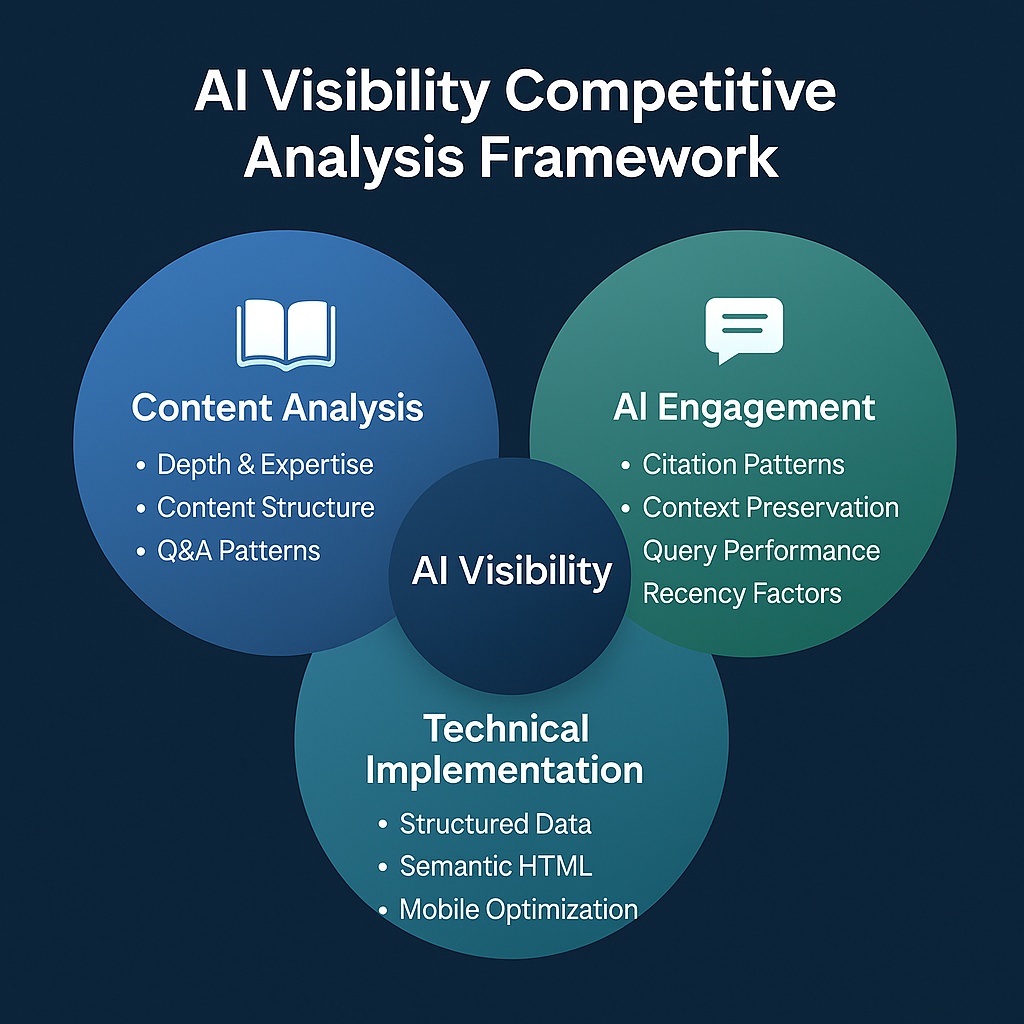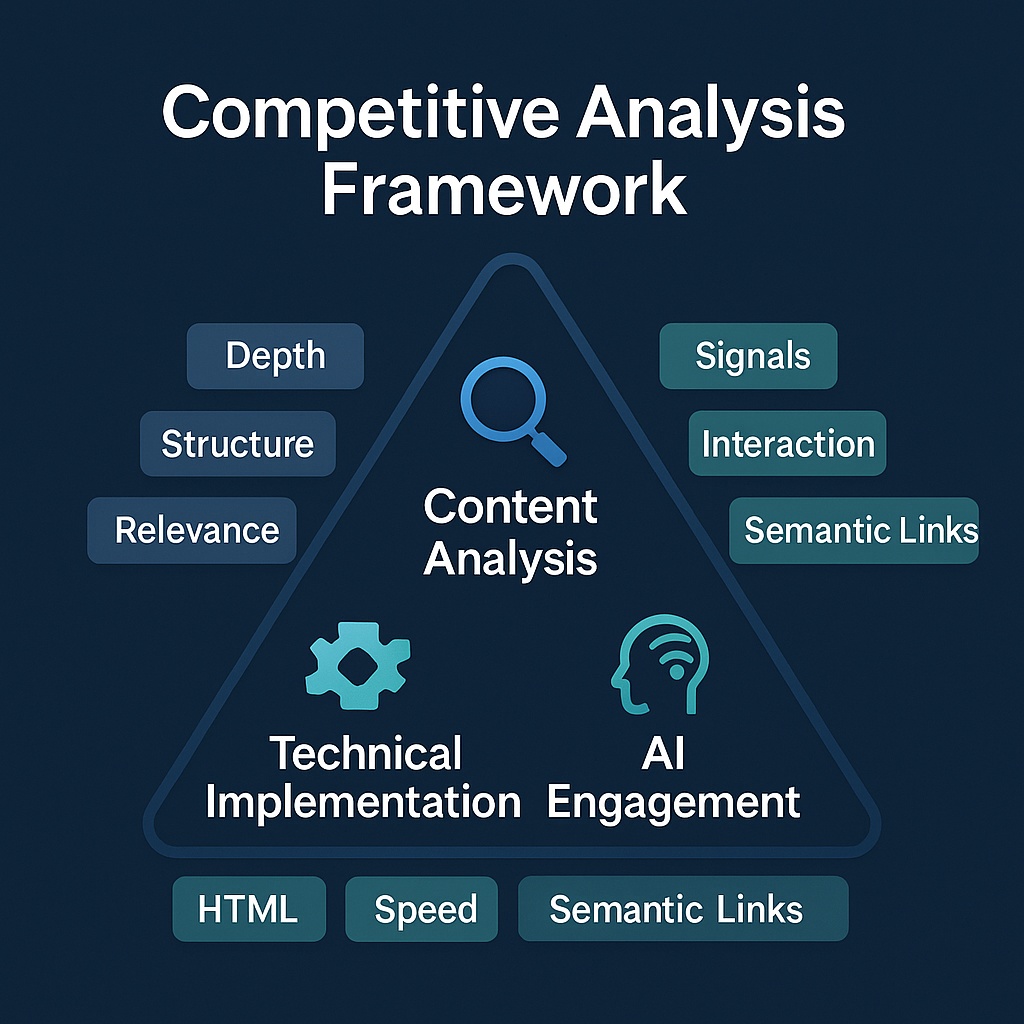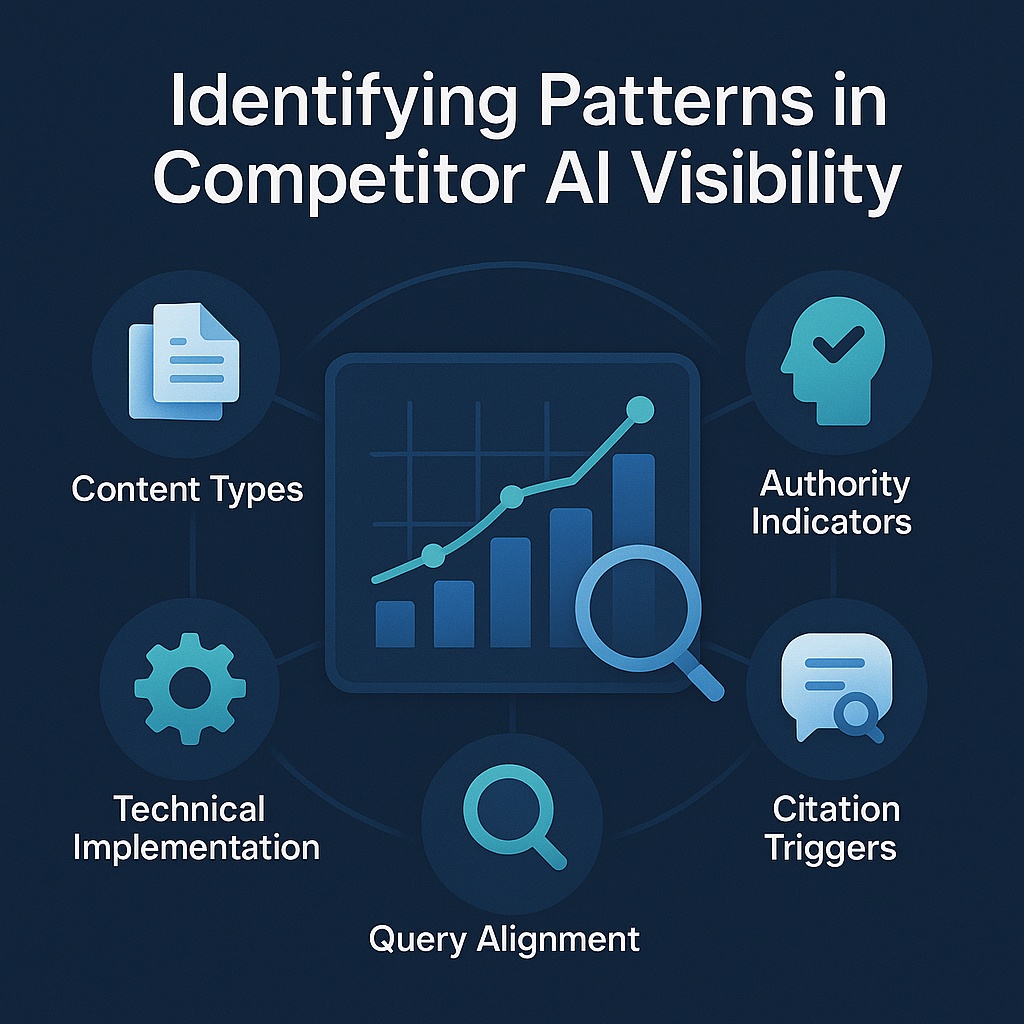Introduction to AI Visibility Competitive Analysis
In the rapidly evolving landscape of search, understanding how your competitors perform in AI-driven environments has become a critical competitive advantage. Unlike traditional SEO competitive analysis, AI visibility analysis requires a deeper understanding of how large language models and AI systems interpret, prioritize, and surface content.
This guide introduces advanced frameworks for conducting comprehensive competitive analysis specifically for AI visibility. You'll learn how to identify which competitors are performing well in AI environments, what strategies they're employing, and how to develop actionable plans to gain an edge.

AI Competitive Analysis Fundamentals
Before diving into specific techniques, it's essential to understand the fundamental principles that make AI competitive analysis different from traditional approaches:
- Content Comprehension vs. Keyword Matching: AI systems understand content semantically rather than simply matching keywords, requiring a deeper analysis of competitors' content quality and topical authority.
- Conversational Context: AI search is often conversational, making context and natural language patterns more important than isolated page optimization.
- Entity-Based Analysis: How competitors structure entity relationships and establish domain expertise is crucial to AI visibility.
- Technical Implementation: Technical structures that help AIs understand content, not just index it, are key competitive differentiators.
- User Engagement Patterns: How users interact with competitive content through AI interfaces affects long-term visibility.
AI Visibility Gap
The measurable difference between how visible a competitor's content is in traditional search versus AI-driven search environments. A large "visibility gap" indicates that content performs significantly better or worse in AI environments compared to traditional search.
Understanding these fundamentals provides the foundation for developing more sophisticated competitive analysis frameworks that specifically address AI visibility factors.
Identifying AI-Visible Competitors
The first step in competitive analysis is identifying which competitors are most visible in AI search environments. This may differ significantly from who ranks well in traditional search results.
Methods for identifying AI-visible competitors include:
- Prompt-Based Competitor Discovery: Systematically testing industry queries across different AI search systems to identify which competitors appear most frequently.
- Content Citation Analysis: Analyzing which sources AI systems tend to cite when answering queries in your industry.
- Visibility Comparison Testing: Comparing traditional search rankings with AI visibility to identify competitors who perform disproportionately well in AI environments.
- Authority Signal Mapping: Identifying which competitors are recognized as authoritative entities within AI knowledge graphs.
Testing Methodology
For comprehensive competitor identification, create a testing matrix of at least 25-50 key industry queries across multiple AI systems (Claude, ChatGPT, Bard, Bing AI). Track which competitors are mentioned, cited, or linked most frequently across these tests to establish a reliable AI visibility ranking.
Once you've identified your top AI-visible competitors, you'll need a systematic approach to analyze what makes them successful. This is where a comprehensive research framework becomes essential.
Comprehensive Research Framework
An effective AI visibility competitive analysis requires a structured framework to examine multiple factors that influence how AI systems interpret and prioritize content. The following framework provides a systematic approach divided into three core areas: content analysis, technical implementation, and AI engagement patterns.

Content Analysis
Content is the foundation of AI visibility. Your analysis should examine how competitors structure and present information in ways that make it easily comprehensible to AI systems:
- Content Depth and Expertise: How thoroughly do competitors cover topics? Do they demonstrate domain expertise through detailed explanations, examples, and technical precision?
- E-E-A-T Signals: How do competitors demonstrate experience, expertise, authoritativeness, and trustworthiness? This includes author credentials, citations, references to research, and transparency about information sources.
- Content Structure: Do competitors use clear, logical structures with well-organized headings, tables, and lists that make information extraction easier for AI systems?
- Entity Relationships: How do competitors establish connections between relevant entities in their content? Do they clearly define industry-specific concepts and their relationships?
- Question-Answer Patterns: Do competitors incorporate FAQ sections or question-answer formats that align with conversational AI interactions?
Analysis Technique: Content Comparison Matrix
Create a scoring matrix for 5-10 of your competitors' most AI-visible pieces of content. Rate each piece on factors like depth (1-10), E-E-A-T signals (1-10), structure clarity (1-10), entity relationship strength (1-10), and conversational alignment (1-10). This provides a quantitative basis for identifying content patterns that correlate with higher AI visibility.
Technical Implementation Analysis
While content is crucial, technical implementation helps AI systems better understand and interpret that content:
- Structured Data Implementation: How extensively do competitors use schema.org markup? Which specific schema types do they prioritize? How granular is their entity definition?
- Semantic HTML: Do competitors use semantic HTML elements effectively to indicate content hierarchy and relationships?
- Natural Language Processing Enhancement: Have competitors implemented any specific technical elements to enhance NLP processing of their content?
- Mobile Optimization: How well is content optimized for mobile devices, which are increasingly the primary access point for AI assistants?
- Content Accessibility: Do competitors follow accessibility best practices that also improve AI content processing?
AI Engagement Pattern Analysis
Understanding how competitors' content is engaged with by AI systems provides crucial insights:
- Citation Patterns: How and when do AI systems cite competitors' content? For what types of queries? With what level of confidence?
- Information Extraction: What specific facts, data points, or explanations do AI systems commonly extract from competitors' content?
- Context Preservation: Do AI systems maintain the original context when referencing competitors' content, or does the original meaning get lost?
- Query Type Performance: For which types of queries (factual, opinion-based, how-to, etc.) are competitors' content most frequently surfaced?
- Recency Bias: How does content age affect the likelihood of AI citation? Do competitors regularly update content to maintain visibility?
AI Citation Authority
The tendency of AI systems to prioritize specific sources when answering queries in a particular domain. High citation authority indicates that AI systems consistently turn to a source when addressing topics in a specific field.
Competitive Analysis Tools for AI Visibility
While AI visibility analysis is still an emerging field, several tools can help systematize your competitive research:
- AIScore Competitive Analysis Module: AIScore's proprietary competitive analysis feature allows direct comparison of AI visibility metrics across competitors.
- Structured Data Testing Tools: Schema markup validators help you analyze competitors' technical implementations.
- AI Response Trackers: Tools that track how AI systems respond to specific queries over time can help identify which competitors are gaining or losing visibility.
- Content Comparison Platforms: AI-powered content analysis tools that evaluate semantic structures and topical coverage depth.
- Prompt Engineering Platforms: Systems that help automate the testing of how competitors' content appears across various AI interactions.
Custom Analysis Toolkit
For comprehensive competitive analysis, we recommend building a custom toolkit that combines automated tools with systematic manual testing. This hybrid approach provides both quantitative data and qualitative insights that purely automated tools might miss.
While tools can streamline the process, effective AI visibility competitive analysis also requires a trained eye to identify patterns and trends that might not be obvious from automated analysis alone.
Identifying AI Visibility Patterns
As you collect data on your competitors' AI visibility, you'll need to identify meaningful patterns that can inform your strategy:
- Content Types: Identify which content formats (guides, case studies, research papers, etc.) consistently achieve higher AI visibility for competitors.
- Authority Indicators: Look for patterns in how competitors establish expertise and authority that resonates with AI systems.
- Citation Triggers: Note specific elements of competitors' content that regularly trigger AI citations.
- Query Alignment: Analyze how competitors align their content with different query types and user intents.
- Technical Implementation: Identify technical patterns that correlate with higher AI visibility.

Creating Your Competitive Advantage Action Plan
Translating competitive analysis into action requires a structured plan that addresses gaps and leverages opportunities:
- Gap Analysis: Identify specific areas where competitors outperform you in AI visibility factors.
- Opportunity Identification: Pinpoint underserved areas or emerging topics where you could establish AI visibility advantages.
- Strategy Development: Create specific strategies to address each gap and opportunity based on competitive insights.
- Implementation Prioritization: Prioritize actions based on potential impact, resource requirements, and implementation difficulty.
- Measurement Framework: Establish metrics to track progress in closing visibility gaps and capturing opportunities.
Competitive Matrix Approach
For each key AI visibility factor, plot where you stand relative to competitors on a simple matrix. The horizontal axis represents your current performance (weak to strong), while the vertical axis represents competitive importance (low to high). This visualization helps identify which factors deserve immediate attention (high importance, weak performance) versus which are less urgent.
Your action plan should include both quick wins and longer-term strategic initiatives to systematically improve your competitive position in AI visibility over time.
Real-World AI Visibility Competitive Analysis Examples
To illustrate effective competitive analysis in practice, consider these industry examples:
Healthcare Industry Example
A leading healthcare provider found that while they ranked well in traditional search for symptom-related queries, AI systems consistently cited one specific competitor when answering health-related questions.
Their competitive analysis revealed that this competitor had:
- Implemented comprehensive medical condition schema markup that defined clear relationships between symptoms, conditions, treatments, and risks
- Created content with clear question-answer structures that aligned with conversational queries
- Published content with explicit citations to medical research and clear authorship by credentialed healthcare professionals
- Used clear, consistent terminology and definitions that helped AI systems establish semantic relationships
By implementing these insights, the healthcare provider saw a 215% increase in AI citations for health queries within six months.
E-Commerce Industry Example
An e-commerce retailer found that product comparison queries in AI search consistently surfaced a competitor's product information, despite having similar traditional search rankings.
Their competitive analysis revealed:
- The competitor had implemented detailed Product and Offer schema with specific product attributes clearly defined
- Product descriptions included comparative information that directly addressed common comparison points
- The competitor maintained a structured knowledge base that established clear entity relationships between products, features, use cases, and alternatives
- Review content was structured to highlight specific product attributes rather than general satisfaction
After applying these insights, the retailer saw their products appear in 73% more AI-driven product comparison responses.
Conclusion
Competitive analysis for AI visibility represents a new frontier in digital marketing strategy. By systematically analyzing how competitors achieve visibility in AI environments, you can develop targeted strategies to improve your own performance.
Remember that AI visibility is not static—it evolves as AI systems improve and as competitive landscapes change. Successful organizations treat competitive analysis as an ongoing process rather than a one-time activity.
The frameworks and techniques outlined in this guide provide a foundation for developing sophisticated competitive intelligence operations specifically for AI search environments. By applying these approaches, you can gain critical insights that help you not just keep pace with competitors, but establish sustainable advantages in AI visibility.
Need Expert Help with AI Competitive Analysis?
Connectica's team of AI visibility specialists can conduct a comprehensive competitive analysis for your business, identifying specific opportunities to gain an edge. Our experts combine technical expertise with strategic insight to develop actionable plans that drive measurable improvements in AI visibility.